Big kit at launched at Canadian show
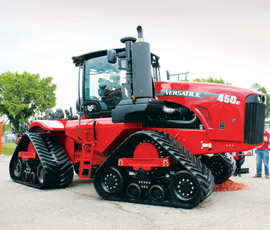
Canada’s Farm Progress Show attracts visitors from miles around to look at everything from snow blowers to haulage trucks. Oliver Mark dodged the thunderstorms (but not the mosquitos) to hunt down some of the world’s biggest farm kit
What is it?
The Farm Progress Show is a yearly farm machinery show held in Regina, Saskatchewan. Regina is a city the size of Reading in a province two-and-a-half times the size of the UK and sits midway between Calgary to the west and Winnipeg to the east on the Great Plains of North America.
The show – a must-see in the Canadian agricultural calendar – attracts more than 40,000 visitors who travel big distances to paw over the monster prairie kit on show. Farms around the treeless flat plains of the Regina area average well over 2,000ha in size and are often family-run businesses growing primary crops of canola and wheat.
Delta Track
Although Versatile’s plans to keep its new Delta Track tractor top secret were blown several months ago, there was still plenty of excitement around the Winnipeg firm’s first foray into the Quadtrac-dominated tracked tractor market.
There are three power options from 450-550hp and a 25-speed Cat powershift. The power is put to the ground through tracks provided by fellow Canadian firm Camoplast, which can be ordered in 30in or 36in widths. Top speed on the road is limited to 35kph to limit the wearing of the rubber tracks and prevent the idler wheels overheating. Keep an eye out for the full review of the Delta Track coming up in Farmers Weekly soon.
Harvesting
Chaser bins are a pretty key ingredient in any North American harvest – most large-acre farmers run at least one to shuffle the grain from combine to road cart – so visitors spent plenty of time kicking the tyres (or tracks) of high capacity haulers at the show.
One of those was Brandt’s new 1322XR, which has a house-sized 35.4t capacity and 50cm auger to unload at up to 17t/min. Unloading speed can be regulated with a hydraulically operated flow gate.
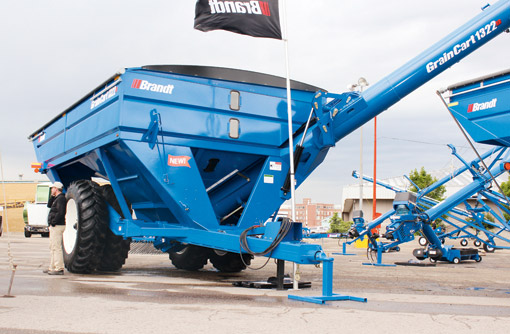
The auger is mounted in the bin’s corner which, according to the company, gives more reach and better visibility than side or front mounted equivalents. There’s a hydraulically adjustable downspout to minimize spillage and help fill the trailer evenly and the auger folds into the chaser’s sidewall during travel.
Underneath there’s an adjustable dual-wheeled walking beam axle with three different positions and the chaser is fitted with big 520/85 R32s.
Empty it weighs 9.5t and it’ll want a 22t tractor on the front, says the company. Price is $72,000 (£48,000).
Drilling kit
Canadian kit builder Bourgault launched a new super-sized grain cart at the show.
The 7950 air-seeder carries five pressurised grain tanks that can be varied in size by shunting the sidewalls back and forth. It means operators can carry enough nitrogen, seed and phosphate to drill as much as 65ha with one load.
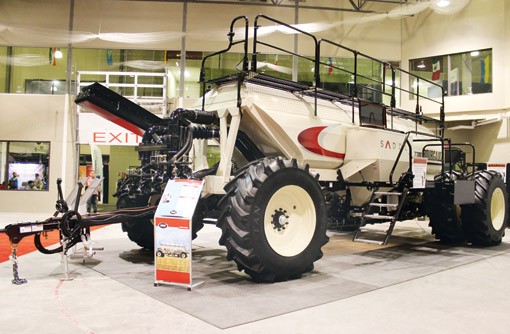
Grain carts of this immensity are designed to allow farmers of 8,000-plus ha to get all their drilling done in tight two-week weather windows. On the front (between the tractor and seed cart) farmers would typically have a 20-26m seeding unit, with most farms running no-till systems to save two precious Canadian commodities – moisture and time.
The seed cart alone weighs almost 22.7t but amazingly it’s the first Bourgault unit to get any sort of braking system – previously they just relied on the tractor’s anchors. It runs on 850 80 R38 tyres (with duals at the rear), which the company believes minimises rolling resistance and offers low ground pressures comparable with tracked units.
The company sells 200-odd units a year across the world. The cart costs $200,000 (£135,000) and a seeding unit in front will add another $300,000 (£200,000). Deep-pocketed farmers typically run these setups for about three years before chopping them in for a new set.
The Seed Hawk stand was the place to be if you’re into monster prairie kit. There were various pieces of no-till equipment stretched out across the plot, but it was the latest air-seeder that drew the crowds.
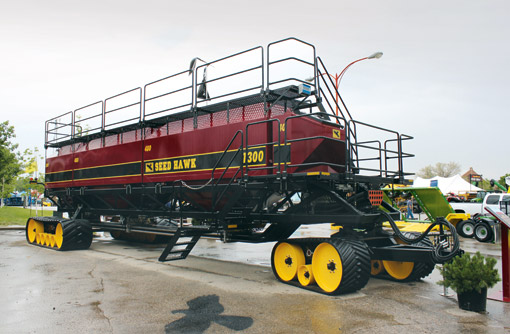
It’s still in its development phase (the builders are probably still trying to work out how on earth farmers will move it) but could well be in production by next year. It measures almost 16m long, 4.3m wide and 4.6m tall so there’s a fair chance the European police would have something to say about its roadworthiness.
The cart tips the scales at 16t and is due to be available with a rear tow hitch and loading conveyor. Camoplast tracks are likely to come as standard in order to lighten the significant compaction risk of pulling such a brute through fields.
The tank is split into three sections – a 10.3t and two 13t parts – and most buyers are expected to add the optional 1t extra tank, too. Metering of the seed/fertiliser is done hydraulically.
Tillage
Although the weather doesn’t always afford Canadian farmers the opportunity to do too much in the way of cultivations, one North American trend that is quickly gathering pace is the move towards strip and vertical tillage.
The latter involves cutting the top couple of inches of soil and trash without disturbing or inverting too much ground in order to conserve moisture lower down the soil profile.

Landoll’s disc unit is a good example of the genre. The 560mm (22in) discs are very shallow – the concave is only 3cm deep – and the gangs are set at just 10deg. Farmers are typically running at about 12kph and the discs should cut straight through any trash without blocking up.
Because of the shallow angle of the gangs the Kansas-made discs aren’t as horsepower hungry and some disc setups – it’ll need about 40hp/m – but working width extends to over 15m. Farmers can also attach rollers or other implements to the rear.
A 10m version weighs in at 11.3t, costs about $88,000 (£60,000) and folds to a rather clumsy 5.5m for transport.
Spraying
You don’t get much more North American than Sprayflex’s Fieldstar 3000 sprayer. A 14,300-litre stainless steel tank piggybacks a tandem axle design, with the boom mid-mounted between the tank and truck cab.
It’s based on an International truck and most of the innards remain the same as it’s road dwelling equivalent. That means operators are treated to air suspension as standard, although the front axle and gearing are tweaked to make it a little more field friendly. Power comes from a 13-litre, 400hp motor up front and drives through a 10-speed auto box.
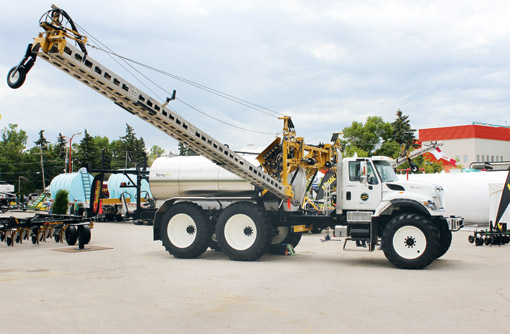
Top speed in low range is 40mph and in high it gets up to 60mph, so it’s ideal for those farmers trekking long distances between fields. It can be fitted with a rear hitch, too, if you’re going to be hooking a bowser on the tail.
Aluminium box boom widths extend to 46m (150ft), but there’s a 54m (180ft) version in the pipeline. There are also smaller models in the US-built range and, because they’re made to order, buyers can pretty much specify what they like including dual wheels.
The asking price is $340,000 (£230,000), so it’ll be at the top end of most buyers’ budgets.
The trailed sprayer market is slowly shrinking the other side of the Atlantic because, as the average farm size grows in Canada and the USA, more farmers are able to justify self-propelled units (the threshold is about 2,000ha).
Despite that, Canadian firm Ag Shield is sticking to mounted and trailed units because there’s too much cost associated with the research and development of high capacity self-propelled units, it says.
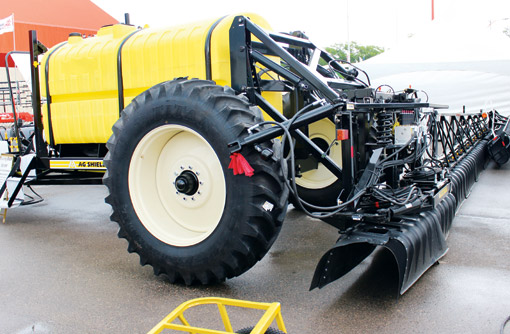
The firm’s bread and butter comes in the form of its wind-protected nozzle sprayers, which allow operators to run safely in winds up to 50kph. Built in Manitoba, Canada, the sprayer sells most commonly in 24m form with a 6,800-litre tank.
The plastic cover is designed to work with 80deg nozzles – ideal for canopy penetration – and it can be shut off over as many as 12 separate sections depending on customer specification. The boom is spring suspended and jockey wheels follow ground contours during early season spraying.
The plastic cover is designed to create a horizontal cyclone. That means as much as 65% of the chemical coats the underpart of crop or weed leaves which, according to the company, makes it far more efficient than the average sprayer.
It’s unlikely we’ll see it in Western Europe any time soon though – the difficulty in folding bulkier booms means transport width is out at 3.7m. There’s also the issue of European type approval, which would prove a costly investment for the company.
Prices start from $78,000 (£52,000).
Novel ideas
For all the monster kit and huge arable acreages there are still plenty of modestly-sized livestock farms in Canada, particularly in the east of the country.
Ag Shield hopes to cater for some of those farmers with its Multi trailer, a multi-tasking bale and flat deck hauler.
In bale mode central and outer spring-assisted wings lift up to cradle as many as 12×1.5m bales across two rows. For unloading the operator just yanks a swing arm to release the entire row at once.
When used as a 9.5m flat deck the triple axle trailer can carry almost 8.2t. It also comes kitted with electrically activated brakes because it’s designed to be towed behind a heavyweight American pickup.
Overall length is almost 12m, width is 2.5m with the wings down and list price is $27,000 (£18,000).
Crop Catcher
Despite the thousands of tons of high value metalwork on show, my favourite find was a small, curved piece of perspex (pictured in scaled down version).
It’s designed to bolt on to the top of combine headers to reduce the amount of chaff and seed that escape the auger’s retractable fingers. It is mounted using 3/8in self-threading bolts and stretches 2.4m long and 55cm high. There are also metre-long extender kits so you can run it along the whole width of your header if you like.
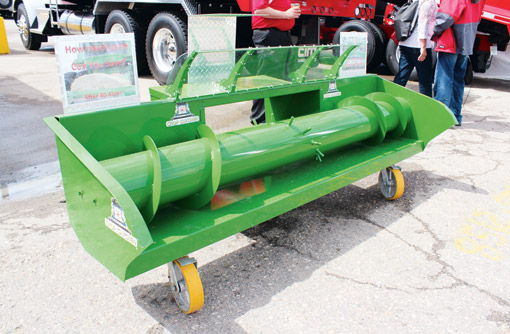
The Crop Catcher will fit any header brand (although Claas and MF have slightly different mounting brackets) and they’ll come painted to match your combine.
The Saskatchewan-made catchers are currently imported into the Netherlands through Pool Agri, so we may well see them in the UK soon. The only stumbling block is the price – at $899 (£600) it seems a little expensive, but it wouldn’t take too long to knock up something similar in the workshop.
See machinery from the Sima 2013 show

